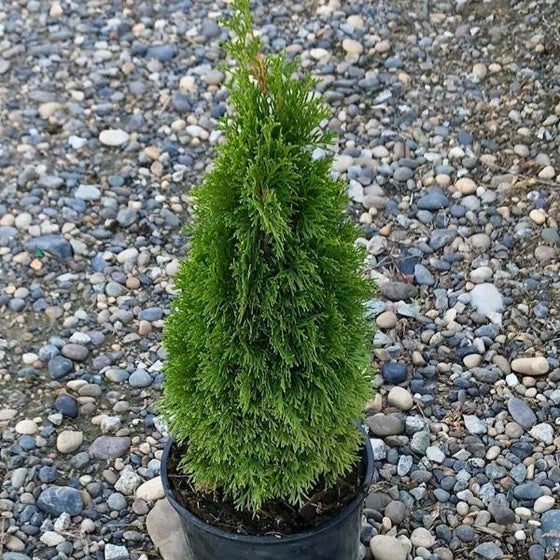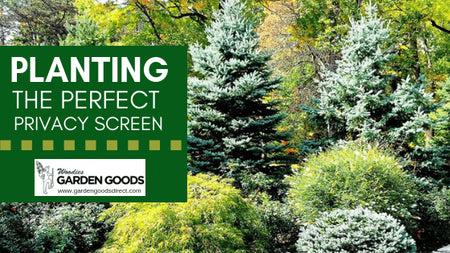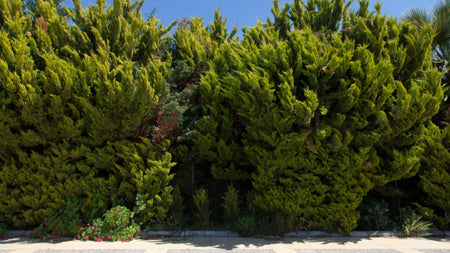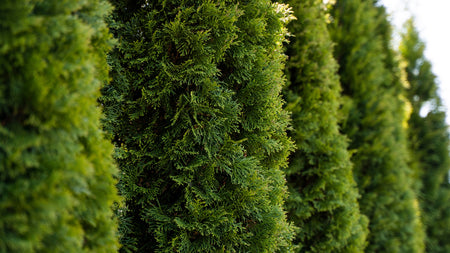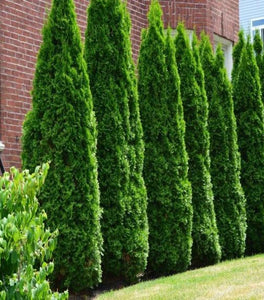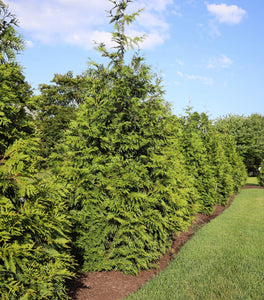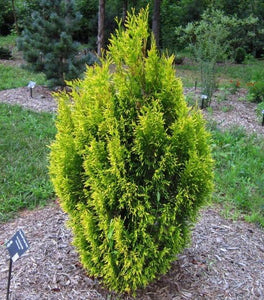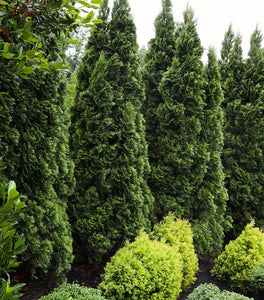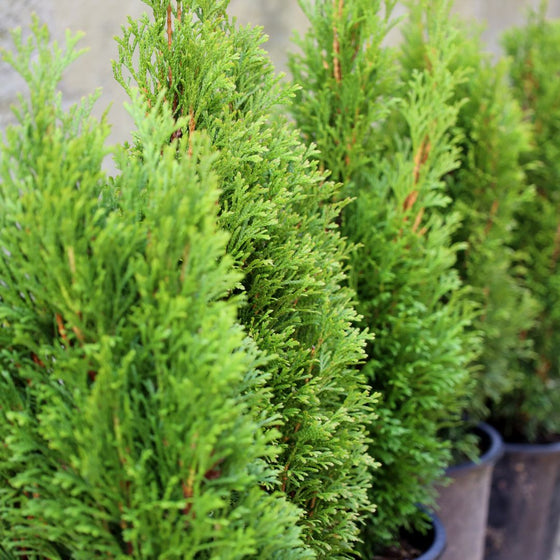
Images Depict Mature Plants
Emerald Petite Arborvitae – Compact Evergreen for Small-Space Privacy and Borders
A space-saving evergreen with year-round appeal.
The Emerald Petite Arborvitae (Thuja occidentalis ‘Emerald Petite’) delivers the classic rich green color and dense texture of Emerald Green Arborvitae in a smaller, more compact form. Growing to just 4–6 feet tall and 2–3 feet wide, it’s the perfect choice for gardeners who want a neat, evergreen screen or accent without overwhelming a small space.
Compact size and low maintenance.
This dwarf arborvitae thrives in USDA Zones 3–7, offering the same cold hardiness and year-round color as its larger relatives, but with a naturally narrow, pyramidal habit. Its slow, steady growth means less pruning and easy care, making it ideal for foundation plantings, walkway borders, or container gardens where space is at a premium.
Versatile design possibilities.
Plant a row of Emerald Petite Arborvitae 2–3 feet apart to create a lush, low hedge, or use individual specimens as evergreen punctuation points in mixed borders. Their dense foliage provides an excellent backdrop for perennials and flowering shrubs, and their tidy shape adds structure and elegance to patios or courtyards.
Tough and dependable year after year.
Once established, Emerald Petite Arborvitae is drought-tolerant and resists common pests and diseases. Whether you’re looking to frame an entryway, soften a fence line, or create a manageable privacy screen, this hardy evergreen delivers classic arborvitae beauty in a compact, easy-care package.

| Hardiness Zone: | 3-7 |
|---|---|
| Mature Height: | 4 to 6 feet |
| Mature Width: | 2 to 3 feet |
| Sunlight: | Full sun |
| Foliage Color: | Glossy bright green |
| Growth Form: | Dense upright and conical |
| Soil Conditions: | Grows best in moist, well drained soils. Acidic, alkaline, and neutral soils all OK |
| Water Requirements: | Keep hydrated in well draining soil |
How to Care for Emerald Petite Arborvitae
Once you buy an Emerald Petite Arborvitae, make sure to read about the care instructions that are required and recommended to keep this plant healthy and thriving.
How do you plant Emerald Petite Arborvitae for a small hedge?
To plant Emerald Petite Arborvitae for a compact hedge or border, choose a site with full sun to partial shade and well-drained soil. Dig each hole twice as wide as the root ball but no deeper, and space plants 2–3 feet apart so their naturally narrow, pyramidal shape will fill in and create a dense evergreen screen. Set the shrub so the top of the root ball is level with the surrounding ground, backfill halfway, water to settle, then finish filling the hole and water again to remove air pockets. Apply a 2–3 inch layer of mulch around the base, keeping it a few inches away from the trunk to prevent rot. Plant in early spring or early fall, when cool, moist weather helps roots establish quickly. These steps give your Emerald Petite Arborvitae the best start for forming a low, tidy hedge with classic emerald-green color.
How often should you water Emerald Petite Arborvitae after planting?
During the first growing season, water each Emerald Petite Arborvitae deeply once or twice per week, soaking the root zone so moisture reaches 8–10 inches deep. Consistent moisture encourages strong root growth and supports the variety’s steady 4–6 foot mature height and 2–3 foot width. Adjust watering in hot, dry periods and reduce frequency when rainfall is adequate. After the first year, Emerald Petite becomes moderately drought-tolerant, requiring supplemental water only during extended dry spells. Maintain a 2–3 inch mulch layer to conserve soil moisture and keep roots cool in summer and insulated in winter, ensuring your dwarf arborvitae retains its lush, deep emerald color year-round.
When and how do you fertilize Emerald Petite Arborvitae trees?
Feed Emerald Petite Arborvitae in early spring with a balanced, slow-release evergreen fertilizer to support healthy foliage and steady growth. Spread the fertilizer evenly around the drip line—about a foot out from the trunk—and water thoroughly so nutrients soak into the soil. This single spring feeding promotes dense emerald-green foliage and strong root development. If your soil is sandy or nutrient-poor, a light midsummer feeding can be applied, but avoid fertilizing after midsummer so new shoots can harden before winter. With this simple annual routine, Emerald Petite Arborvitae maintains its vibrant color and compact, 4–6 foot size with minimal maintenance.

How and when do you prune Emerald Petite Arborvitae for a tidy shape?
Emerald Petite Arborvitae naturally holds a tight, pyramidal habit, so heavy pruning is rarely necessary. In late winter or early spring, before new growth begins, inspect each plant and remove any dead, damaged, or crossing branches with clean, sharp pruners. This encourages good air circulation and keeps the shrub healthy and attractive. For a formal hedge or a slightly more manicured look, lightly trim stray tips in late spring after the first flush of growth. Avoid cutting back into old wood because arborvitae does not regenerate from bare stems. With occasional light pruning, your Emerald Petite Arborvitae will remain a dense, compact evergreen screen that provides year-round color with very little effort.


